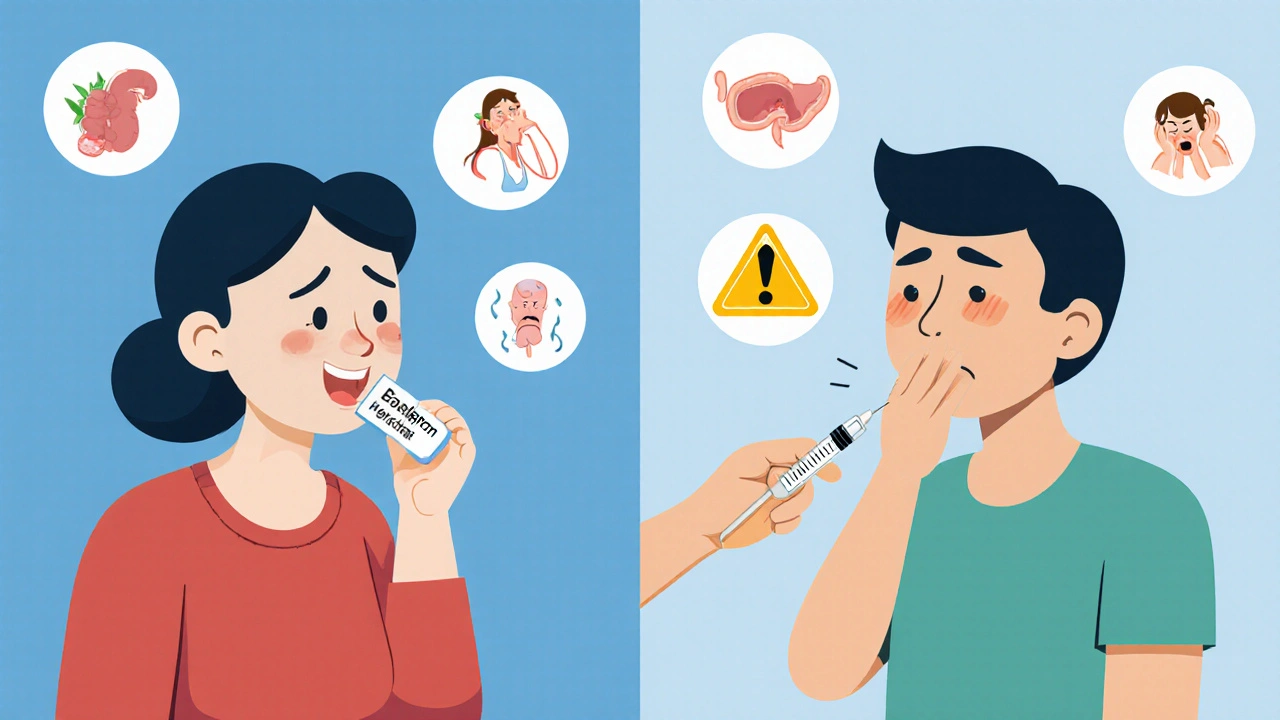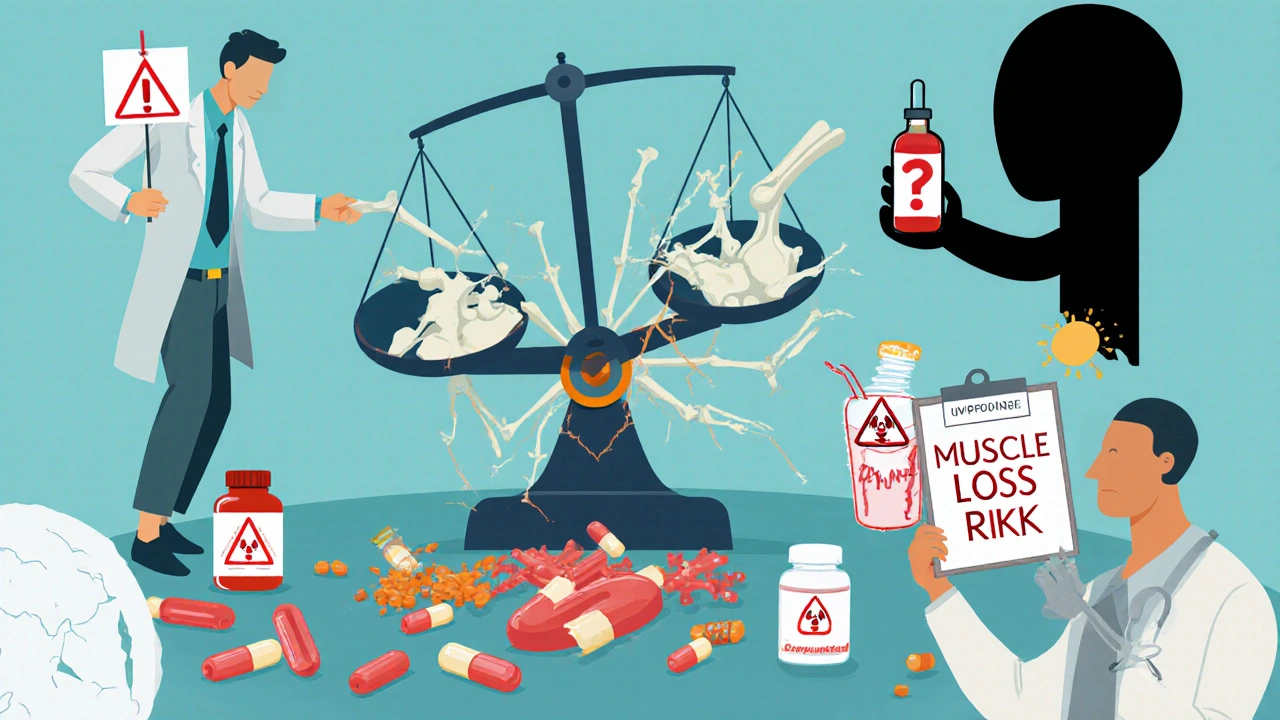GLP-1 Side Effect Risk Calculator
Side Effect Risk Assessment
Enter your treatment details to estimate your risk of common side effects like nausea, vomiting, and diarrhea.
Estimated Side Effect Risk
0%When you hear about GLP-1 agents, you might think of weight loss headlines or diabetes news. But the latest wave of these drugs isn’t just stronger-it’s more complex, and that changes everything about how they affect your body. By 2025, next-generation GLP-1 agents like retatrutide, orforglipron, and VK2735 are no longer experimental. They’re in late-stage trials or already approved, delivering weight loss numbers that were unthinkable a decade ago-up to 24% in some cases. But with greater power comes new questions: Are these drugs safer? Or just more powerful in their side effects?
What Makes These Agents ‘Next-Generation’?
First-generation GLP-1 drugs like liraglutide and exenatide worked by mimicking one hormone: glucagon-like peptide-1. That helped lower blood sugar and made people feel full. But they didn’t do much else. Newer agents go further. Retatrutide is a triple agonist-it hits GLP-1, GIP, and glucagon receptors all at once. That’s why it’s showing weight loss of up to 24.2% after 48 weeks in trials. Retatrutide is a next-generation triple receptor agonist developed by Eli Lilly, designed to amplify metabolic effects by activating three hormonal pathways simultaneously. Then there’s Orforglipron, the first oral GLP-1 agonist to show serious results. In trials, people lost 15-20% of their body weight without injections. That’s a game-changer for people who hate needles.
Even VK2735, a dual GLP-1/GIP agonist similar to tirzepatide, delivered nearly 15% weight loss in just 13 weeks. These aren’t incremental improvements. They’re leaps forward in how we treat obesity and metabolic disease.
Side Effects: Are They Getting Better?
If you’ve taken semaglutide or liraglutide, you know the drill: nausea, vomiting, diarrhea. These aren’t rare-they happen in 30-50% of users. The big surprise? The newer drugs don’t fix this. In fact, Wen et al.’s 2025 study found that despite adding more receptors, gastrointestinal side effects didn’t decrease. If anything, they stayed just as bad. People on retatrutide reported nausea and vomiting at rates similar to semaglutide, even at higher doses.
That’s counterintuitive. You’d think activating more pathways would smooth things out. But the body doesn’t work that way. More activation means more stimulation of gut receptors, which leads to more nausea and slower digestion. The good news? Most people adapt. Clinical trials show 70-80% of side effects fade within 4 to 8 weeks if you stick with the dose. But that’s cold comfort when you’re vomiting for weeks.
Oral vs. Injectables: A Different Kind of Risk
Orforglipron’s big selling point is that you swallow it. No shots. But that doesn’t mean it’s easier on your body. In fact, its side effect profile is nearly identical to injectables. The main difference? You might be more likely to stop taking it if you’re not used to pills. People report stomach upset, bloating, and loss of appetite just like with injections.
There’s another layer: compounded GLP-1 agents. These aren’t FDA-approved. They’re mixed in back-alley pharmacies, often with inconsistent doses. The University of Illinois at Chicago’s Digital Pharmacy warned in August 2025 that these versions carry 3-5 times higher risk of serious side effects. Patients have reported sudden dizziness, heart palpitations, and even hospitalizations because the concentration of the drug varied wildly from vial to vial. If you’re considering a compounded version, ask your doctor: Is this pharmacy USP <795>-compliant? If they don’t know what that means, walk away.

What No One’s Talking About: Muscle and Bone Loss
Most people focus on weight loss. But losing 20% of your body weight fast isn’t just about fat. It’s also about muscle. Dr. Daniel J. Drucker, a leading expert in hormone research, pointed out in his 2025 Nature Reviews article that rapid weight loss from these drugs could lead to significant muscle wasting. That’s a problem if you’re older, active, or trying to stay strong. The body doesn’t distinguish between fat and muscle when it’s in calorie deficit-especially when appetite suppression is this strong.
Studies haven’t fully measured this yet. But early data from retatrutide trials show declines in lean mass that mirror what’s seen in extreme dieting. The American Gastroenterological Association’s 2022 guidelines also flagged a lingering concern: pancreatitis. While the risk is low, it’s still there. And with more people using these drugs for longer, we’ll need years of data to be sure.
Long-Term Safety: The Big Unknown
Most clinical trials last 1-2 years. But people are taking these drugs for 5, 10, even 20 years. What happens then? We don’t know. The University of Illinois at Chicago’s August 2025 guidance explicitly says the long-term safety of agents causing over 15-20% weight loss is “incompletely characterized.” That’s not a red flag-it’s a warning light.
Questions remain about bone density. Rapid weight loss can weaken bones, especially in postmenopausal women. Nutritional status is another concern. If your appetite is shut down for years, are you getting enough protein, vitamins, or minerals? Many patients on these drugs start taking supplements, but there’s no standardized guidance yet.

Who Should Be Using These Drugs?
These aren’t for everyone. The FDA approved semaglutide and tirzepatide for adults with obesity or overweight with at least one weight-related condition-like high blood pressure, type 2 diabetes, or sleep apnea. But now, doctors are seeing patients come in asking for them just to look slimmer. That’s risky. The side effects aren’t trivial. And the long-term effects? Still unknown.
These drugs work best for people who’ve tried diet and exercise and still struggle. They’re not magic pills. They’re tools. And like any tool, they need to be used with care. Dose titration matters. Starting low and going slow cuts side effects in half. Most experts recommend taking 16-20 weeks to reach the full dose. Rushing it leads to more nausea, more dropout.
The Market Is Exploding-But So Are the Risks
The global market for GLP-1 drugs is expected to hit $120 billion by 2030. Novo Nordisk and Eli Lilly dominate. But new players like Viking Therapeutics and Merck are rushing in. That’s good for innovation. But it’s also good for hype. Social media is full of before-and-after photos. But behind those photos are people who quit because they couldn’t tolerate the side effects. About 5-10% of users drop out of trials because nausea or vomiting became unbearable.
And while prescriptions for obesity jumped from 1.2 million in 2022 to 12.7 million in 2024, access is uneven. Insurance coverage is patchy. Cost is high. And compounded versions are flooding the market, often sold as “generic” alternatives. They’re not. They’re dangerous.
What’s Next?
Retatrutide’s Phase III results are expected by late 2025 or early 2026. That’s when we’ll see real-world safety data on weight loss above 20%. Orforglipron’s oral form could be approved by 2027. VK2735 is still in Phase 3. All of them are being tested for uses beyond weight loss-like fatty liver disease, Parkinson’s, and even heart failure.
But the focus is shifting. Researchers aren’t just trying to make drugs that cause more weight loss. They’re trying to make ones that cause less nausea. That’s the next frontier: better tolerability. Some are working on delayed-release versions. Others are testing lower doses paired with appetite-regulating supplements.
For now, the message is simple: These drugs work. But they’re not risk-free. The side effects are real. The long-term effects? Still being written. If you’re considering one, talk to your doctor-not a TikTok influencer. Get blood work. Monitor your muscle strength. Track your nutrition. And never, ever take a compounded version unless you’ve verified the pharmacy’s credentials.
Next-generation GLP-1 agents are powerful. But power without understanding is dangerous. The science is moving fast. Your safety shouldn’t be an afterthought.
Do next-generation GLP-1 agents have fewer side effects than older ones?
No. Despite being more potent and targeting multiple hormones, next-generation GLP-1 agents like retatrutide and VK2735 cause gastrointestinal side effects-such as nausea, vomiting, and diarrhea-at similar or higher rates than older drugs like semaglutide. Research from 2025 shows that adding more receptor targets doesn’t reduce these side effects; it may even make them worse at higher doses.
Can I take oral GLP-1 agents like orforglipron instead of injections?
Yes, orforglipron is an oral GLP-1 agonist that has shown weight loss results comparable to injectables in clinical trials. It’s not yet FDA-approved as of late 2025, but Phase 3 trials are on track for approval by 2027. It’s designed for patients who prefer pills over injections, but it still carries the same gastrointestinal side effect profile. It’s not safer-just more convenient.
Are compounded GLP-1 drugs safe?
No. Compounded GLP-1 drugs are not FDA-approved and often have inconsistent dosing, impurities, or incorrect ingredients. The University of Illinois at Chicago’s Digital Pharmacy reported that patients using compounded versions have 3-5 times higher rates of serious adverse events, including dizziness, heart palpitations, and hospitalizations. Always use FDA-approved products like semaglutide, tirzepatide, or retatrutide from licensed pharmacies.
Do these drugs cause muscle loss?
Yes, rapid and substantial weight loss-especially above 15-20%-can lead to loss of lean muscle mass. Experts like Dr. Daniel J. Drucker warn that this is a growing concern, particularly in older adults or those who are physically active. Monitoring protein intake and engaging in resistance training can help, but muscle loss remains an underreported risk in current clinical data.
How long do side effects last?
For most people, nausea, vomiting, and other gastrointestinal side effects improve within 4 to 8 weeks if the dose is stabilized. Around 70-80% of patients see significant relief by then. However, side effects can return if the dose is increased too quickly. Slow titration over 16-20 weeks is the best way to reduce discomfort and improve adherence.
Is it safe to use these drugs long-term?
Long-term safety data beyond 5 years is still limited. While short-term trials show good results, concerns remain about bone density, muscle preservation, nutritional status, and potential effects on organs like the pancreas and gallbladder. Ongoing studies, including those for retatrutide, are tracking these risks. Until more data is available, regular medical monitoring is essential for anyone using these drugs long-term.

Theresa Ordonda
October 30, 2025 AT 10:30Judy Schumacher
October 31, 2025 AT 21:19Megan Raines
November 1, 2025 AT 13:17Anthony Griek
November 2, 2025 AT 17:37Norman Rexford
November 3, 2025 AT 16:54Wayne Keller
November 4, 2025 AT 20:23Shana Labed
November 6, 2025 AT 06:11California Daughter
November 7, 2025 AT 11:00Vishwajeet Gade
November 8, 2025 AT 20:54